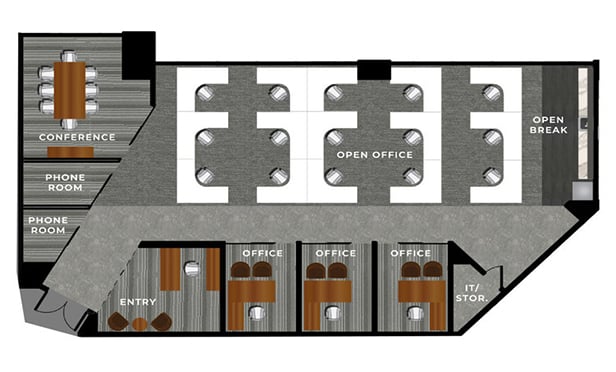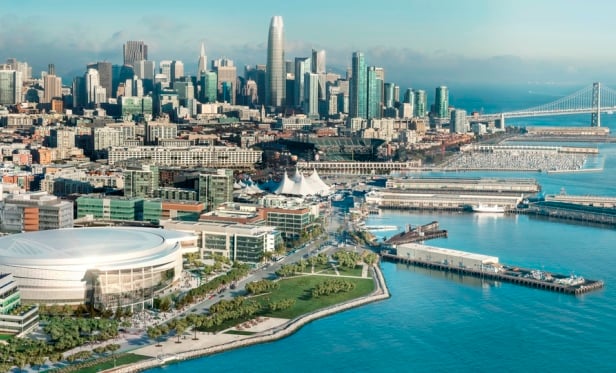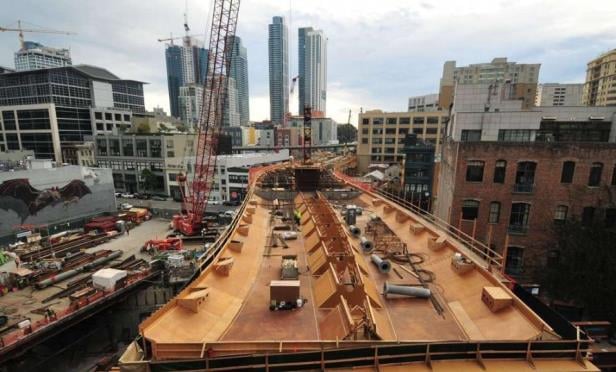
LOS ANGELES—Growth in the office sector nationally cooled during the first quarter, according to reports from CBRE and Cushman & Wakefield. CBRE on Friday reported a modest increase of 10 basis points in vacancies from the previous quarter, while Cushman & Wakefield's tale of net absorption told of a steeper decline compared to the year-ago period.
Suburban vacancies and downtown vacancies each increased by 10 bps during Q1, to 14.2% and 10.7%, respectively, for an overall office vacancy rate of 13.0%. CBRE attributes the increase to an uptick in supply, while noting that vacancies continued to fall in nearly half of the US office markets it measures and that the national vacancy rate remains near its post-recession low.
As with most real estate metrics, vacancy increases or declines vary among local markets. At the one end of the spectrum, Kansas City, MO/KS saw a 150-bp drop from Q4 2016, while at the other end, Nashville's vacancies rose by 250 bps due to an influx of new construction.
”The office market appears to have reached equilibrium and the strong economy, including solid employment numbers, is likely to help offset rising supply,” says Jeffrey Havsy, Americas chief economist for CBRE. “Several markets are likely to continue to soften, but the overall office market remains relatively healthy.”
Cushman & Wakefield's take on the vacancy rate differs somewhat in that the firm measures it as unchanged from Q4 at 13.2%, although that's just a 10-bp rise from the cyclical low of 13.1% seen in Q3 '16. Net absorption, though, declined 39% from a year ago to 6.8 million square feet, the lowest level seen in five years. However, it marked the 26th consecutive quarter of positive absorption in the office sector, continuing a record streak.
“We have observed two major shifts in the office sector over the past two years,” says Ken McCarthy, Cushman & Wakefield principal economist and applied research lead. “The first was that tenant demand in the country's technology hubs began to cool off, and that trend has continued into early 2017.
“The second shift is occurring on the supply side,” he continues. “Developers are clearly cranking it up, but the space is mostly getting delivered in places that need it most.”
The firm's global chief economist, Kevin Thorpe, notes that the domestic economy continues to add jobs, “and most US markets remain fundamentally healthy. But the combined pressures of slower job creation and rising office construction is beginning to place upward pressures on vacancy rates, particularly in the larger US cities.”
Cushman & Wakefield reports that 102.8 million square feet of office space was under construction as Q1 ended, the second highest level in 17 years. Fifty-one percent of that tally is in markets that have absorbed large amounts of space during the recovery, led by Manhattan with 12 million square feet in the pipeline.
“Although absorption levels are expected to remain healthy, given the growing supply pipeline, it is likely that we have reached an inflection point in the cycle where we will observe a gradual uptrend in US vacancy rates for the next 12-18 months,” says Thorpe.

LOS ANGELES—Growth in the office sector nationally cooled during the first quarter, according to reports from CBRE and Cushman & Wakefield. CBRE on Friday reported a modest increase of 10 basis points in vacancies from the previous quarter, while Cushman & Wakefield's tale of net absorption told of a steeper decline compared to the year-ago period.
Suburban vacancies and downtown vacancies each increased by 10 bps during Q1, to 14.2% and 10.7%, respectively, for an overall office vacancy rate of 13.0%. CBRE attributes the increase to an uptick in supply, while noting that vacancies continued to fall in nearly half of the US office markets it measures and that the national vacancy rate remains near its post-recession low.
As with most real estate metrics, vacancy increases or declines vary among local markets. At the one end of the spectrum, Kansas City, MO/KS saw a 150-bp drop from Q4 2016, while at the other end, Nashville's vacancies rose by 250 bps due to an influx of new construction.
”The office market appears to have reached equilibrium and the strong economy, including solid employment numbers, is likely to help offset rising supply,” says Jeffrey Havsy, Americas chief economist for CBRE. “Several markets are likely to continue to soften, but the overall office market remains relatively healthy.”
Cushman & Wakefield's take on the vacancy rate differs somewhat in that the firm measures it as unchanged from Q4 at 13.2%, although that's just a 10-bp rise from the cyclical low of 13.1% seen in Q3 '16. Net absorption, though, declined 39% from a year ago to 6.8 million square feet, the lowest level seen in five years. However, it marked the 26th consecutive quarter of positive absorption in the office sector, continuing a record streak.
“We have observed two major shifts in the office sector over the past two years,” says Ken McCarthy, Cushman & Wakefield principal economist and applied research lead. “The first was that tenant demand in the country's technology hubs began to cool off, and that trend has continued into early 2017.
“The second shift is occurring on the supply side,” he continues. “Developers are clearly cranking it up, but the space is mostly getting delivered in places that need it most.”
The firm's global chief economist, Kevin Thorpe, notes that the domestic economy continues to add jobs, “and most US markets remain fundamentally healthy. But the combined pressures of slower job creation and rising office construction is beginning to place upward pressures on vacancy rates, particularly in the larger US cities.”
Cushman & Wakefield reports that 102.8 million square feet of office space was under construction as Q1 ended, the second highest level in 17 years. Fifty-one percent of that tally is in markets that have absorbed large amounts of space during the recovery, led by Manhattan with 12 million square feet in the pipeline.
“Although absorption levels are expected to remain healthy, given the growing supply pipeline, it is likely that we have reached an inflection point in the cycle where we will observe a gradual uptrend in US vacancy rates for the next 12-18 months,” says Thorpe.
Want to continue reading?
Become a Free ALM Digital Reader.
Once you are an ALM Digital Member, you’ll receive:
- Breaking commercial real estate news and analysis, on-site and via our newsletters and custom alerts
- Educational webcasts, white papers, and ebooks from industry thought leaders
- Critical coverage of the property casualty insurance and financial advisory markets on our other ALM sites, PropertyCasualty360 and ThinkAdvisor
Already have an account? Sign In Now
*May exclude premium content© 2025 ALM Global, LLC, All Rights Reserved. Request academic re-use from www.copyright.com. All other uses, submit a request to [email protected]. For more information visit Asset & Logo Licensing.








